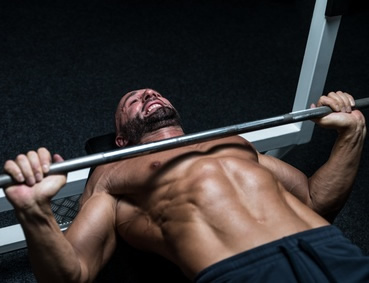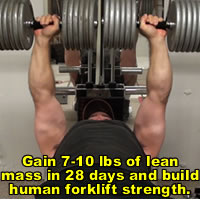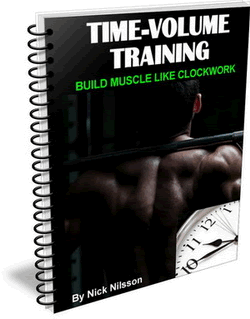Everybody wants a bigger bench press... that's not even a question.
And here's the thing...if you've hit a plateau in your bench press numbers, it may not be due to problems gaining strength or lack of muscle mass...it may be due to problems in your pressing TECHNIQUE.

If your bench technique is off, you're leaving a LOT of pounds on the table...pounds that you could be adding to your lift RIGHT NOW.
The form point I'm going to address here deals with your back and shoulder blades. If you're thinking "what do my back and shoulder blades have to do with my bench press"...you're in for a real treat.
Because if you don't know about this form point, you've got potential for MASSIVE improvement in your bench press from what you're going to learn in the next few minutes alone.
Your back and shoulder blades are critical to your bench press.
It's important to understand this before I get into the training technique itself (and if you already know this, still read this..it's a good review and will really help set up the exercise).
Your back muscles act as direct antagonists to your chest muscles. They act to stabilize the shoulder girdle during the bench press. To maximize this stabilization, you need to be actively contracting your back muscles during the press, primarily during the lowering phase, up until just before the change of direction.
When your back is "solid" (and pulling your shoulder blades tightly together), it gives you a solid base of support from which to press and keeps the shoulders back so that you're pressing more with the chest than with the anterior delts.
This is a major reason why many people have a hard time feeling their pecs working when benching...the back is not locked in and the anterior delts have a better line of pull than the pecs...so they take over at the bottom, until the triceps kick in after the sticking point to finish out the movement. The pecs are just taking up space on the front of their body and never get well developed.
When your back muscles are not engaged, your torso will get "mashed down" or flattened by the weight bearing down on you, causing this positioning issue. This is more pronounced as you get into heavier and heavier loads. Your anterior delts and triceps can only increase in strength to a certain level before they just can't compensate anymore.
That's when you hit a plateau that you can't break through.
That's why at the start of your bench press sets you need to set your body in the proper position by pulling your shoulder blades in TIGHT behind you.
And THAT, in turn, is why you also need to focus on strengthening your back in order to bench press more.
In terms of exercises, pretty much ANY back training you do is going to helpful for this purpose. Just having a stronger back in general is going to allow you to more strongly engage the muscles of the back and maintain that engagement during the exercise, helping to keep that ideal bench press position.
(And as a side note in terms of absolute amount of weight lifted, when you have a thicker back and you can maintain a body position that essentially makes your torso thicker, that means your effective range of motion for the exercise is reduced...and shorter range of motion means you can lift more weight. This is why the best bench pressers in the world often resemble a fireplug with T-Rex arms...their range of motion is a fraction of what most people have to lift through).
How to Use Bands to FORCE Your Body Into PERFECT Bench Press Position
Now we get into the fun stuff...how to make this perfect position happen and how to strengthen it.
|
We're going to use a very strategic setup in the power rack (and yes, you WILL need a power rack to do this one effectively). You'll also need a pair of light resistance bands.
This is my recommended source for training bands. (Note: Use Coupon Code "rbtfitstep" to get 10% off your purchase of a band package)
The bands I would recommend for this technique would be the red (small) ones. You don't need or even WANT thicker bands for this technique.
That site offers multi-band packages as well, which I HIGHLY recommend (if you don't have any bands at all right now). In general, I find bands to be extremely effective training tools and I use mine a lot for a variety of exercises and techniques.
Set up a flat bench in the power rack. If you normally use a bench press station, you'll need to learn how to set up properly in the rack. It's very simple, luckily. Just set your bench in the rack and use an empty bar to play around with racking pin heights (the hooks where you set the bar at the start of the exercise).
For THIS exercise, we're going to set the safety rails to just below the halfway point in the range of motion. So with your empty bar, lie on your bench, and lower the bar down...the rails should stop the movement a few inches before you touch the bar to your chest. These few inches are critical for our purposes.
Hitch your two bands to the top side beams of the rack, as you see in the picture below. It's a simple of matter of just putting the band over top then pulling one end through the loop of the other end, then tightening it up. You're NOT going to be attaching the bands to the bar here...

What you're going to be doing is putting your HANDS through the dangling loops of the bands.


Once they're in, make sure the bands are sitting around your wrists. Shift forward on the bench then lie back.

Next, grip the bar exactly as you normally would for a bench press. The bands will looped on the backs of your wrists and will be locked into position.

Before you unrack the bar, get your shoulders blades pulled in tight behind your body. This is something you need to get in the habit of doing every single time you bench.
Once you're locked in, unrack the bar and move it into the top position.

Now, if you've never done Reverse Band Bench Press before, you will notice that as the bands stretch, they take up some of the weight from you. That's how that exercise works...the lower you go, the easier it gets.
Because we're using light bands, the reduction in load won't be a whole lot. It's worth noting that THIS is not the reason why you'll be able to increase your bench press 10 to 20 lbs...that's still coming.

Here's the "money" part of this technique...when the bar sets down on the rails RELEASE YOUR GRIP ON IT and CONTINUE PULLING YOUR HANDS DOWN AS FAR AS YOU CAN GO.

The bands will provide direct resistance against this movement... the peak contracted position for the back and the PERFECT position for strengthening the EXACT muscles in the EXACT place and in the EXACT way they need to be strengthened.
In addition, your body's natural tendency will be to tuck your elbows in closer to your body to help pull the bands down.
Again, this is PERFECT positioning for a stronger bench press. Your elbows should not be flared out wide to the sides... they should be tucked at an angle.
The bands are forcing your body into the absolute total perfect position for a stronger bench press...it literally has no choice.
Now HOLD this position for a few seconds. The contraction should literally be PAINFUL... and you should do everything you can to maximize this contraction... shoulders back, chest out, back of your head pressed into the bench.
Once you've squeezed this contraction for a few seconds, hold that position in your back... DO NOT let your shoulders shift forward... and re-grip the bar by straightening the elbows.

Now develop tension in the pecs and POWER the bar off the rails, all the way to the top position of the exercise. It's important not to "pop" the bar off the rails. Instead, imagine as though there's something sticky on the rails and you have to "peel" the bar off by first developing tension through your upper body.
THEN you explode the bar up.

You will feel the effectiveness of this technique from the VERY FIRST REP.
You will feel more locked in...you will feel stronger...you will feel your pecs firing (maybe for the first time ever in a bench press!)...and you will very likely feel less torque in your shoulder joints.
Now the party is just getting started...lower the bar and do it again. Repeat for a set of 6 to 8 reps.
The key point to remember is to squeeze the back muscles HARD at the bottom of every single rep for at least 3 to 5 seconds.
Teaching and Strengthening the Bench Press For BIG Jumps in Strength
This technique is going to accomplish two major things...
First, it's going to teach you how to properly tighten your back during a bench press and second, it's going to strengthen the specific muscles needed to do so.
LEARN this lesson and you will be instantly stronger in your normal bench pressing.
TRAIN this lesson consistently and you will accelerate your bench press strength by leaps and bounds over where you were before.
![]()
More From Fitstep.com
| Countdown Alternating Sets for Legs | |
| 3 Things People Do To Totally Screw Up Their Fat Loss | |
| Pizza, French Fries, Beer...and Other Diet Foods | |
| Breathe Backwards For More Effective Pulldowns |
Share This Page...
---
Home -> Exercise Library -> Chest Exercises -> Bands to Increase Bench Press



